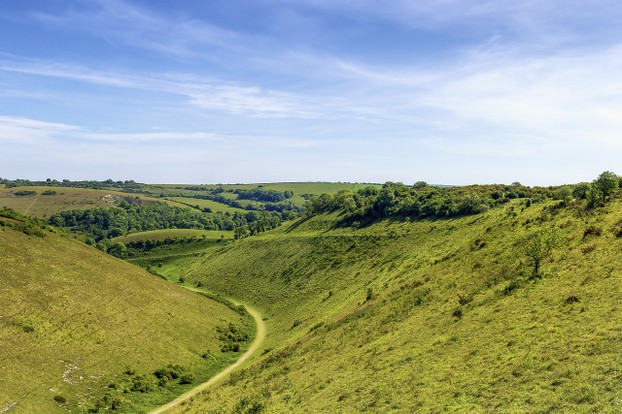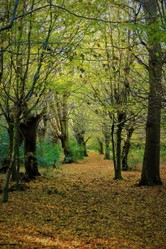Jack and Jill went up the hill
To fetch a pail of water.
Jack fell down and broke his crown
And Jill came tumbling after
Why? You usually find water in valley bottoms. Is this just a nonsense rhyme? No! The rhyme almost certainly originates in the chalk hills of Southern England.. At places in this area we find the phenomenon of dry valleys, which originated in the last years of the ice age, but have no stream running through them, as the extremely porous chalk allows water to sink through it with ease. But why the upper slopes of these uplands? The answer is what are known as dew ponds. Not all dewponds are on hills, but many are on upper slopes to catch dew and fog droplets that condense on higher places.. Dewponds probably were first constructed in the Neolithic Age, 4200 to 1900 BC. Neolithic Britons could not manage the dense woodlands of the country and so preferred the more expansive chalk uplands of the south Downs, the Chilterns and Salisbury Plain, and the oolitic limestone of the Cotswold hills. But these had porous soils. The solution to the problem of water storage was to create large, shallow basins, waterproofed with puddled clay to store water.
These ponds were not a source of water suitable for arable farming, which is water-intensive, but they could easily serve as watering holes for cattle in a pastoral economy. But surprisingly dew was probably not the source of the water, as scientists have tested them and found that very little dew is collected in them. But the ponds could serve well as reservoirs for rainwater storage. They could also be more aptly named dew or fog ponds. While dew is air-borne moisture which condenses out of the air, fog is already condensed water droplets that settles from the air much more easily than dew does.
The dew ponds fell out of use in the twentieth century. In 1937 a dewpond builder died and his son wrote to clients promising that the family business of constructing dewponds, which the family had been conducting for two hundred and fifty one years, would continue. But then came the Second World War, and agriculture was affected by the urgent rush to modernize to survive. The dew pond is now a relic.







 Pilgrimage. A review18 days ago
Pilgrimage. A review18 days ago
 Leo the Fourteenthon 05/09/2025
Leo the Fourteenthon 05/09/2025
 The Melsonby Hoardon 03/25/2025
The Melsonby Hoardon 03/25/2025



Comments
Wood bank is the only term that I know to describe what is a minor landscape feature.Sorry. I do not think that there is another term.
The first paragraph to your fourth subheading, Wood Banks, describes "A large square of land surrounded by an earthen bank about three feet high" as a woodbank.
That does not seem to me the term that west-ponders use even as I find its meaning, spelling and use clear.
Would there be any synonyms, and would you by any chance know what word west-ponders use?
It would be legally treasure trove, a legal status given to gold and silver discovered in the ground. The judge who makes the decision on this matter determines whether it was deliberately abandoned or whether the owner had concealed it with the intention of recovery .if the latter is true it either goes back to the owner or if the owner is long dead with no heirs the state takes the treasure but pays the finder and the landowner the value of the treasure as identified by a suitably qualified assessor.
Thank you!
That's interesting about Balmoral Castle. Some online source -- may have been authoritative, may not, because how can west pond-siders compete with east pond-siders ultimately for accuracy of all things British Isles?;-D -- mentioned Balmoral Castle as the favorite place for royal family members to stay. Might there be an indication somewhere how much Queen Victoria paid (and might she have gotten a royal discount ;-D?)?
Regarding the high tide mark inland, King John might have lost much of the royal treasure in the Wash, according to west-pond sources. Without royal ownership of beaches from high tide mark inland, would it be finders-keepers if someone found that treasure or would it no matter what just automatically go to its last true owners, the royal family?
Good question. The monarch acts on the advice of the prime minister, but if it is not a parliamentary issue she can act on the advice of the privy council, the monarch's council. Victoria would have authorised the Crown Estate , which manages the monarch's properties, to legally organize the transfer. Victoria's transfer would have to come through the Crown Estate because she owned the forest in virtue of her role as monarch. This is different from her ownership of Balmoral Castle, which she bought in a private capacity.
All forests in Britain and many beaches down from the high tide mark belong to the Crown.
The first paragraph to your next-to-last subheading, Wood banks, references Queen Victoria donating Epping Forest for Londoner recreation.
Would she have made that decision on her own? And would there have been some economic or political advantage to her doing so?
No offencevwasvtaken. Boys do things thatbtheybshuddervaboutbin later years.
I hope that my comments did not sound chiding.
But it's unsettling to think of you and your brother -- like children like to do -- swinging from branch to branch.
Those long, low, straightly outward branches look safely swingable. But they may be what arborists call dog legs. Arborists here think that the term suggests a branch that looks sturdy but that may break quite disastrously.
Two years ago I was walking under a dog leg that somehow caught my hair. It went crashing down when I reached up to untangle my hair from a twig.
My youngest brother got up to worse. But we all survived.
Of course Derdriu, you are right. But boys will be boys, and we get up to things that make us flinch in later life. I have done alsorts of exploits that make me shudder now! I did not identify the trees. I would have got very wet had I fallen in.But the more mature me would not have been so daring. However, I am now 72.